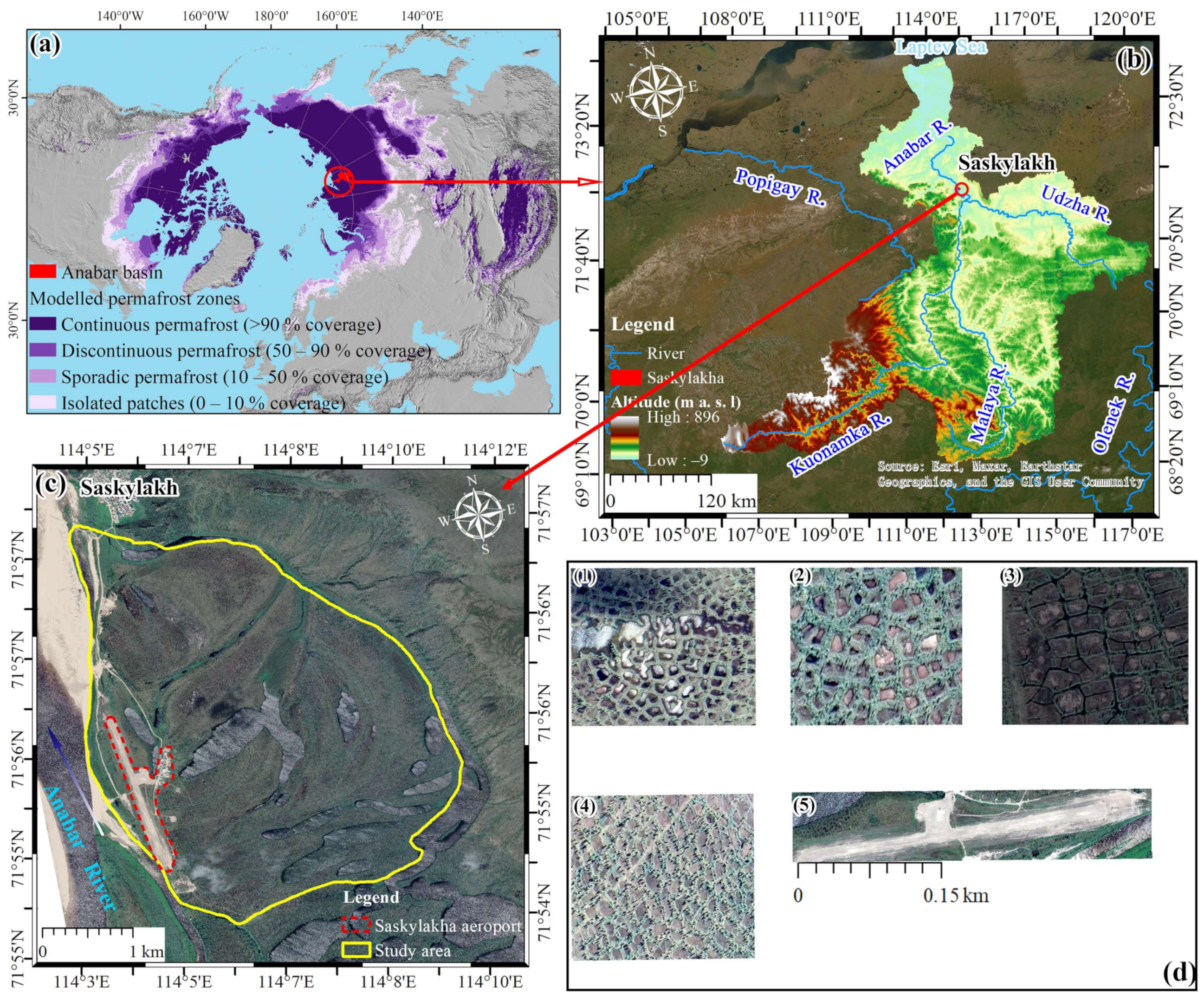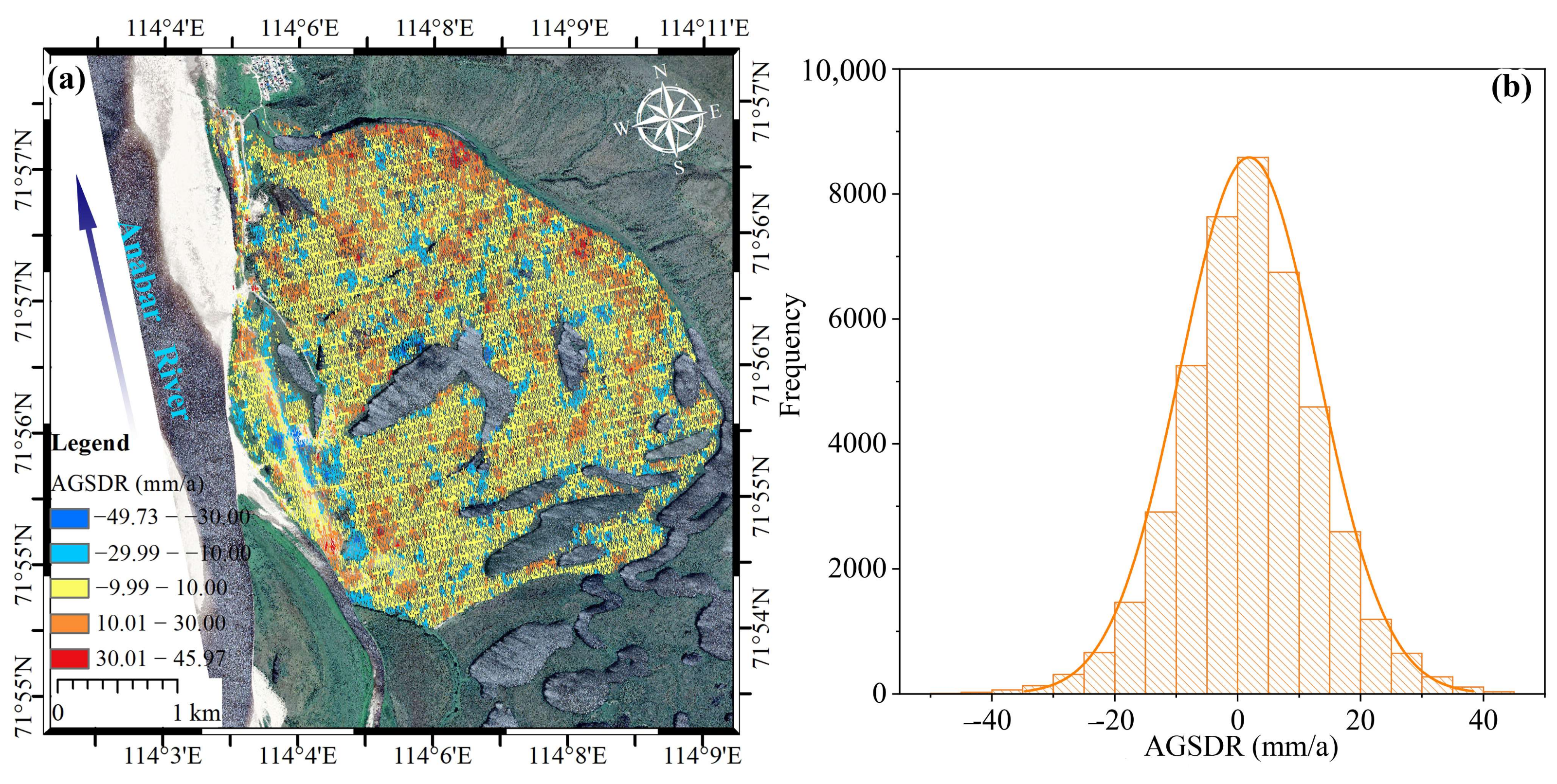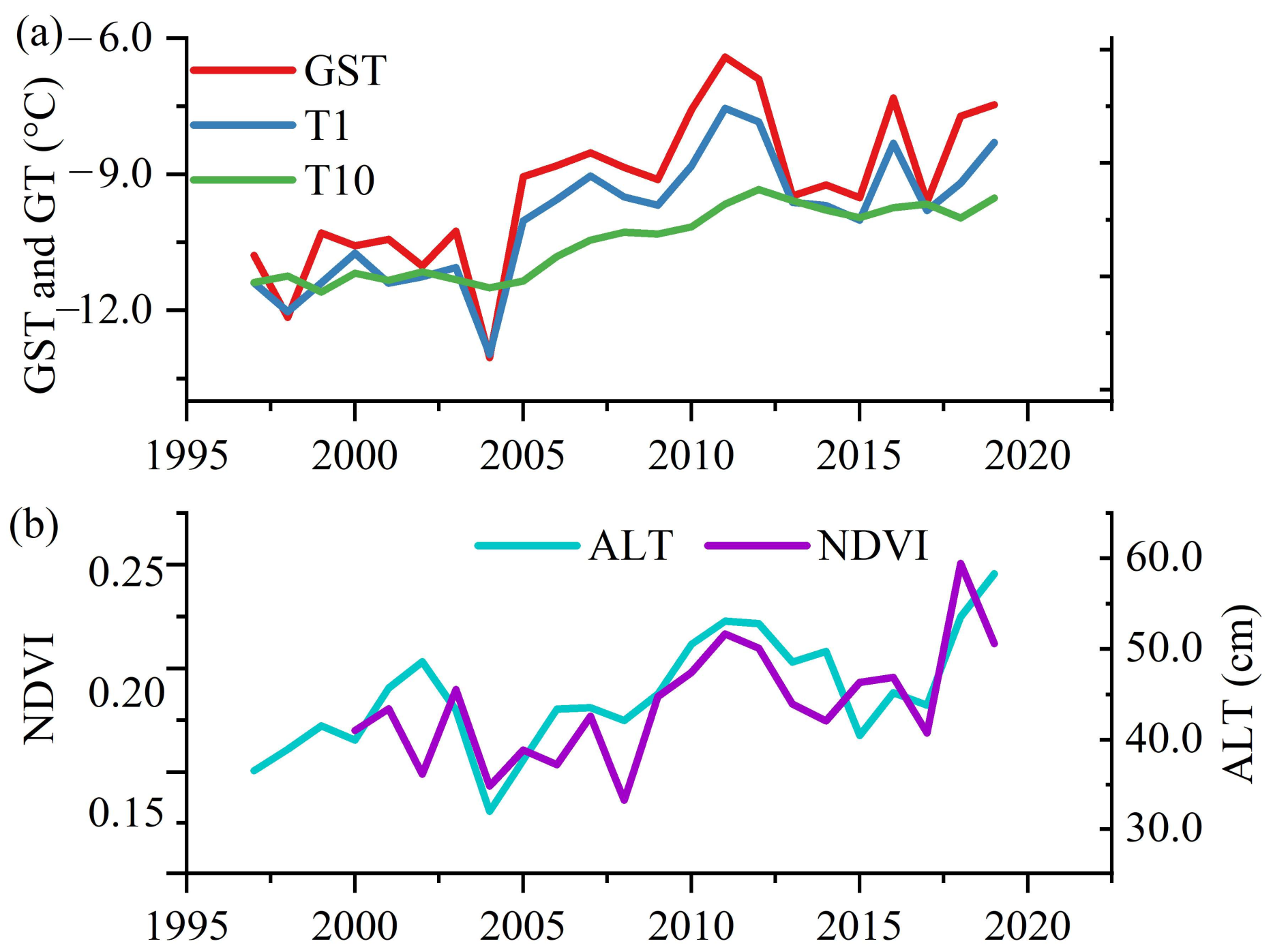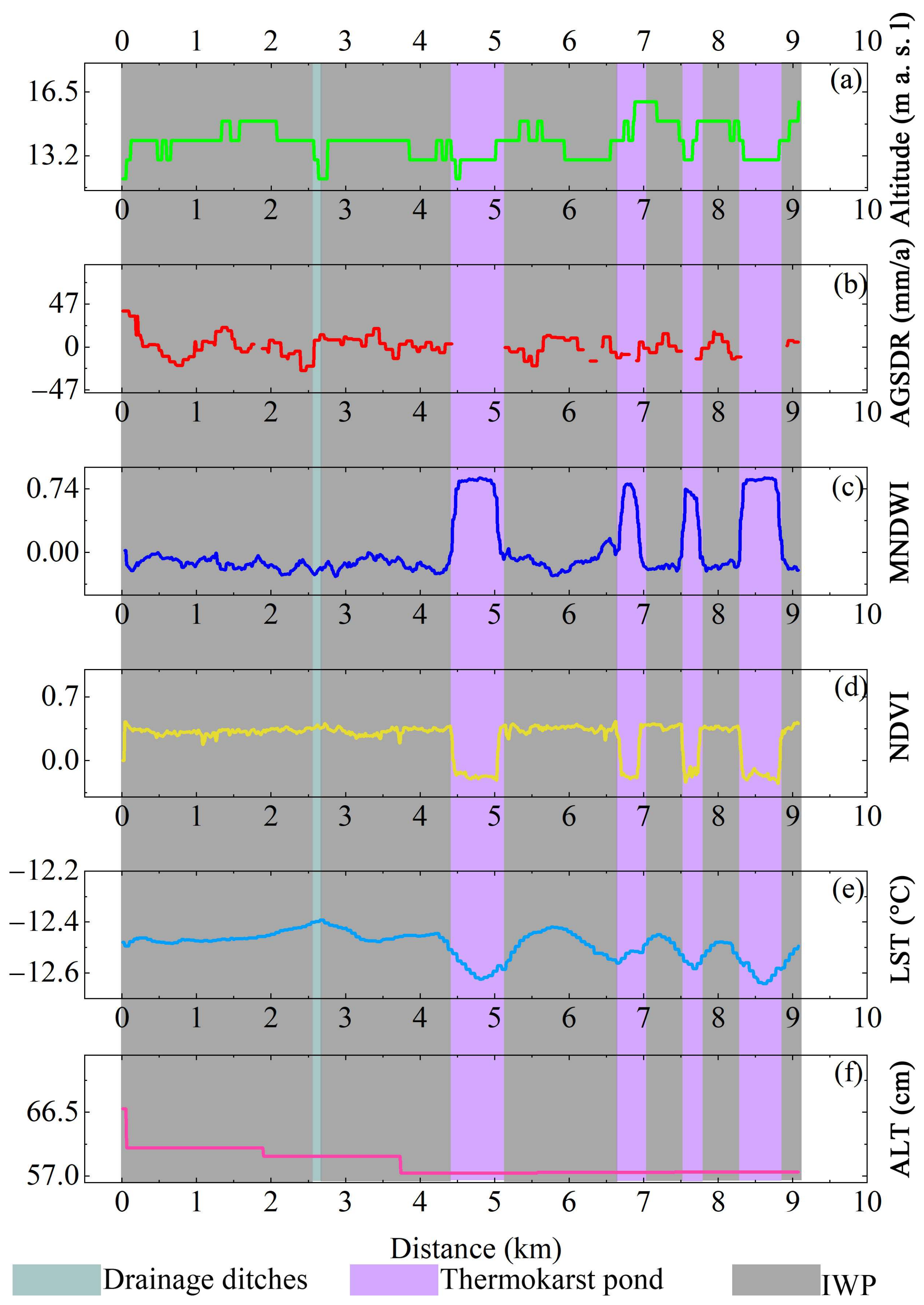Monitoring Ground Surface Deformation of Ice-Wedge Polygon Areas in Saskylakh, NW Yakutia, Using Interferometric Synthetic Aperture Radar (InSAR) and Google Earth Engine (GEE)
Abstract
:1. Introduction
2. Study Area and Sites in Saskylakh
3. Data and Methods
3.1. SAR Data
3.2. Optical Data
3.3. Permafrost Data
3.4. SBAS-InSAR
3.5. Evaluation of Theoretical Precision
3.6. Other Methods
3.6.1. Normalized Difference Vegetation Index (NDVI)
3.6.2. Modified Normalized Difference Water Index (MNDWI)
3.6.3. Land Surface Temperature (LST)
3.6.4. Selection of Ice-Wedge Polygon (IWP) Areas
3.6.5. Transect Selection
4. Results
4.1. SBAS-InSAR Accuracy Verification by Phase Variance
4.2. GSD Rate in the Study Area and Different Areas of Ice-Wedge Polygons (IWPs)
4.3. Ground Temperatures and Active Layer Thickness (ALT)
4.4. Development of Thermokarst Lakes and Ponds
4.5. Permafrost Environment Reflected by Study Transects
5. Discussions and Prospects
5.1. Changes in the Permafrost Environment
5.2. GSD of Ice-Wedge Polygons (IWPs) and Permafrost Dynamics
5.3. Prospects
6. Conclusions
- (1)
- The AGSDR in Saskylakh ranged from −49.73 to 45.97 mm/a in 2018–2019, and in 75% of the study area, the AGSDR was between −10~10 mm/a;
- (2)
- All GSD points in the region indicated a closer relationship between GSD and LST for our observational points with larger AGSDR, and positive correlation between GSD and LST for those points with negative AGSDR, and vice versa;
- (3)
- Further, the GSDs of the five Aeroport areas indicated the most drastic deformation under engineering disturbances in the Saskylakh Aeroport area; and the GSDs of the six LCP and six HCP areas indicated that the GSDs of most LCPs and HCPs are negatively correlated with LST;
- (4)
- Arctic permafrost in Saskylakh showed a trend of degradation, as evidenced by rising ground temperature and NDVI (shown as denser and taller vegetation), a deepening active layer, and expanding thermokarst lakes and ponds;
- (5)
- Spatially, the higher the vegetation cover, the higher the LST and the larger the ALT.
Author Contributions
Funding
Data Availability Statement
Acknowledgments
Conflicts of Interest
References
- Schirrmeister, L.; Kunitsky, V.; Grosse, G.; Wetterich, S.; Meyer, H.; Schwamborn, G.; Babiy, O.; Derevyagin, A.; Siegert, C. Sedimentary characteristics and origin of the Late Pleistocene ice complex on north-east Siberian Arctic coastal lowlands and islands—A review. Quat. Int. 2011, 241, 3–25. [Google Scholar] [CrossRef] [Green Version]
- Klerk, P.D.; Donner, N.; Karpov, N.S.; Minke, M.; Joosten, H. Short-term dynamics of a low-centred ice-wedge polygon near Chokurdakh (NE Yakutia, NE Siberia) and climate change during the last ca 1250 years. Quat. Sci. Rev. 2011, 30, 3013–3031. [Google Scholar] [CrossRef]
- Walter, K.M.; Zimov, S.A.; Chanton, J.P.; Verbyla, D.; Chapin, F. Methane bubbling from Siberian thaw lakes as a positive feedback to climate warming. Nature 2006, 443, 71–75. [Google Scholar] [CrossRef] [PubMed]
- Schuur, E.A.; Bockheim, J.; Canadell, J.G.; Euskirchen, E.; Field, C.B.; Goryachkin, S.V.; Hagemann, S.; Lafleur, P.M.; Lee, H. Vulnerability of permafrost carbon to climate change: Implications for the global carbon cycle. Bioscience 2008, 58, 701–714. [Google Scholar] [CrossRef] [Green Version]
- Isaev, A.P.; Protopopov, A.V.; Protopopova, V.V.; Gorova, A.A.; Timofeyev, P.A.; Nikolaev, A.N.; Shurduk, I.F.; Lytkina, L.P.; Ermakov, N.B.; Nikitina, N.V.; et al. Vegetation of Yakutia: Elements of ecology and plant sociology. In The Far North: Plant Biodiversity and Ecology of Yakutia; Springer: Dordrecht, The Netherlands, 2010; pp. 143–260. [Google Scholar] [CrossRef]
- Kuznetsova, L.V.; Zakharova, V.I.; Sosina, N.K.; Nikolin, E.G.; Ivanova, E.I.; Sofronova, E.V.; Poryadina, L.N.; Mikhalyova, L.G.; Vasilyeva, I.I.; Remigailo, P.A.; et al. Flora of Yakutia: Composition and ecological structure. In The Far North: Plant Biodiversity and Ecology of Yakutia; Springer: Dordrecht, The Netherlands, 2010; pp. 24–140. [Google Scholar] [CrossRef]
- Naumov, Y.M. Soils and soil cover of northeastern Eurasia. In Cryosols: Permafrost-Affected Soils; Springer: Berlin/Heidelberg, Germany, 2004; pp. 161–183. [Google Scholar] [CrossRef]
- Matsuoka, N.; Christiansen, H.; Watanabe, T. Ice-wedge polygon dynamics in Svalbard: Lessons from a decade of automated multi-sensor monitoring. Permafr. Periglac. Process. 2018, 29, 210–227. [Google Scholar] [CrossRef] [Green Version]
- Grosse, G.; Robinson, J.E.; Bryant, R.; Taylor, M.D.; Harper, W.; DeMasi, A.; Kyker-Snowman, E.; Veremeeva, A.; Schirrmeister, L.; Harden, J. Distribution of Late Pleistocene ice-rich syngenetic permafrost of the Yedoma Suite in east and central Siberia, Russia. US Geol. Surv. Open File Rep. 2013, 1078, 1–37. [Google Scholar]
- Schirrmeister, L.; Froese, D.; Tumskoy, L.; Grosse, G.; Wetterich, S. Yedoma: Late Pleistocene ice-rich syngenetic permafrost of Beringia. Encycl. Earth Sci. Ser. 2013, 2, 542–552. [Google Scholar]
- Jorgenson, M.T.; Shur, Y.L.; Pullman, E.R. Abrupt increase in permafrost degradation in Arctic Alaska. Geophys. Res. Lett. 2006, 33, 1–4. [Google Scholar] [CrossRef]
- Raynolds, M.K.; Walker, D.A.; Ambrosius, K.J.; Brown, J.; Everett, K.R.; Kanevskiy, M.; Kofinas, G.P.; Romanovsky, V.E.; Shur, Y.; Webber, P.J. Cumulative geoecological effects of 62 years of infrastructure and climate change in ice-rich permafrost landscapes, Prudhoe Bay Oilfield, Alaska. Glob. Change Biol. 2014, 20, 1211–1224. [Google Scholar] [CrossRef]
- Liljedahl, A.K.; Boike, J.; Daanen, R.P.; Fedorov, A.N.; Frost, G.V.; Grosse, G.; Hinzman, L.D.; Iijma, Y.; Jorgenson, J.C.; Matveyeva, N.; et al. Pan-Arctic ice-wedge degradation in warming permafrost and its influence on tundra hydrology. Nat. Geosci. 2016, 9, 312–318. [Google Scholar] [CrossRef]
- Farquharson, L.M.; Romanovsky, V.E.; Cable, W.L.; Walker, D.A.; Kokelj, S.V.; Nicolsky, D. Climate change drives widespread and rapid thermokarst development in very cold permafrost in the Canadian High Arctic. Geophys. Res. Lett. 2019, 46, 6681–6689. [Google Scholar] [CrossRef] [Green Version]
- Steedman, A.E.; Lantz, T.C.; Kokelj, S.V. Spatio-temporal variation in high-centre polygons and ice-wedge melt ponds, Tuktoyaktuk Coastlands, Northwest Territories. Permafr. Periglac. Process. 2017, 28, 66–78. [Google Scholar] [CrossRef]
- Zhang, W.; Witharana, C.; Liljedahl, A.; Kanevskiy, M. Deep convolutional neural networks for automated characterization of Arctic ice-wedge polygons in very high spatial resolution aerial imagery. Remote Sens. 2018, 10, 1487. [Google Scholar] [CrossRef] [Green Version]
- Abolt, C.J.; Young, M.H. High-resolution mapping of spatial heterogeneity in ice wedge polygon geomorphology near Prudhoe Bay, Alaska. Sci. Data 2020, 7, 87. [Google Scholar] [CrossRef] [PubMed] [Green Version]
- Bhuiyan, M.A.E.; Witharana, C.; Liljedahl, A.K. Use of very high spatial resolution commercial satellite imagery and deep learning to automatically map ice-wedge polygons across tundra vegetation types. J. Imaging 2020, 6, 137. [Google Scholar] [CrossRef]
- Rettelbach, T.; Langer, M.; Nitze, I.; Jones, B.; Helm, V.; Freytag, J.C.; Grosse, G. A quantitative graph-based approach to monitoring ice-wedge trough dynamics in polygonal permafrost landscapes. Remote Sens. 2021, 13, 3098. [Google Scholar] [CrossRef]
- Wainwright, H.M.; Oktem, R.; Dafflo, B.; Dengel, S.; Curtis, J.B.; Torn, M.S.; Cherry, J.; Hubbard, S.S. High-resolution spatio-temporal estimation of net ecosystem exchange in ice-wedge polygon tundra using in situ sensors and remote sensing data. Land 2021, 10, 722. [Google Scholar] [CrossRef]
- Abolt, C.J.; Young, M.H.; Atchley, A.L.; Harp, D.R. Microtopographic control on the ground thermal regime in ice wedge polygons. Cryosphere 2018, 12, 1957–1968. [Google Scholar] [CrossRef] [Green Version]
- Zlotnik, V.A.; Harp, D.R.; Jafarov, E.E.; Abolt, C.J. A model of ice wedge polygon drainage in changing Arctic terrain. Water 2020, 12, 3376. [Google Scholar] [CrossRef]
- O’Neill, H.B.; Christiansen, H.H. Detection of ice wedge cracking in permafrost using miniature accelerometers. J. Geophys. Res. Earth Surf. 2018, 123, 642–657. [Google Scholar] [CrossRef]
- Morse, P.D.; Burn, C.R. Field observations of syngenetic ice wedge polygons, outer Mackenzie Delta, western Arctic coast, Canada. J. Geophys. Res. Earth Surf. 2013, 118, 1320–1332. [Google Scholar] [CrossRef]
- Kanevskiy, M.; Shur, Y.; Walker, D.A.; Jorgenson, T.; Raynolds, M.K.; Peirce, J.L.; Jones, B.M.; Buchhorn, M.; Matyshak, G.; Bergstedt, H.; et al. The shifting mosaic of ice-wedge degradation and stabilization in response to infrastructure and climate change, Prudhoe Bay Oilfield, Alaska, USA. Arct. Sci. 2022, 8, 498–530. [Google Scholar] [CrossRef]
- Christiansen, H.; Matsuoka, N.; Watanabe, T. Progress in understanding the dynamics, internal structure and palaeoenvironmental potential of ice wedges and sand wedges. Permafr. Periglac. Process. 2016, 27, 365–376. [Google Scholar] [CrossRef]
- Fedorov, A.N.; Konstantinov, P.Y.; Vasiliev, N.F.; Basharin, N.I.; Shepelev, A.G.; Andreeva, V.A.; Semenov, V.P.; Torgovkin, Y.I.; Desyatkin, A.R.; Zheleznyak, M.N.; et al. Ice Volumes in Permafrost Landscapes of Arctic Yakutia. Land 2022, 11, 2329. [Google Scholar] [CrossRef]
- Obu, J.; Westermann, S.; Bartsch, A.; Berdnikov, N.; Christiansen, H.H.; Dashtseren, A.; Delaloye, R.; Elberling, B.; Etzelmüller, B.; Kholodov, A.; et al. Northern Hemisphere permafrost map based on TTOP modelling for 2000–2016 at 1 km2 scale. Earth Sci. Rev. 2019, 193, 299–316. [Google Scholar] [CrossRef]
- Luo, D.; Wu, Q.; Jin, H.; Marchenko, S.S.; Lü, L.; Gao, S. Recent changes in the active layer thickness across the northern hemisphere. Environ. Earth Sci. 2016, 75, 555. [Google Scholar] [CrossRef]
- Durre, I.; Menne, M.J.; Gleason, B.E.; Houston, T.G.; Vose, R.S. Comprehensive automated quality assurance of daily surface observations. J. Appl. Meteorol. Climatol. 2010, 49, 1615–1633. [Google Scholar] [CrossRef] [Green Version]
- Menne, M.J.; Durre, I.; Vose, R.S.; Gleason, B.E.; Houston, T.G. An overview of the global historical climatology network-daily database. J. Atmos. Ocean Technol. 2012, 29, 897–910. [Google Scholar] [CrossRef]
- Gorokhov, A.N.; Fedorov, A.N. Current trends in climate change in Yakutia. Geogr. Nat. Resour. 2018, 39, 153–161. [Google Scholar] [CrossRef]
- Persits, F.M.; Ulmishek, G.F. Maps Showing Geology, Oil and Gas Fields, and Geologic Provinces of the Arctic. In U.S. Geological Survey Open-File Report 97-470; U.S. Geological Survey: Reston, VA, USA, 2003. [Google Scholar] [CrossRef]
- Washburn, A.L. Classification of patterned ground and review of suggested origins. Geol. Soc. Am. Bull. 1956, 67, 823–866. [Google Scholar] [CrossRef]
- Drew, J.; Tedrow, J.J.A. Arctic soil classification and patterned ground. Arctic 1962, 15, 109–116. Available online: http://www.jstor.org/stable/40506980 (accessed on 8 January 2023). [CrossRef] [Green Version]
- MacKay, J. Thermally induced movements in ice-wedge polygons, western Arctic coast: A long-term study. Géogr. Phys. Quat. 2002, 54, 41–68. [Google Scholar] [CrossRef] [Green Version]
- De, Z.F.; Guarnieri, A.M. TOPSAR: Terrain observation by progressive scans. IEEE Trans. Geosci. Electron. 2006, 44, 2352–2360. [Google Scholar] [CrossRef]
- Attema, E.; Cafforio, C.; Gottwald, M.; Guccione, P.; Guarnieri, A.M.; Rocca, F.; Snoeij, P. Flexible dynamic block adaptive quantization for Sentinel-1 SAR missions. IEEE Geosci. Remote Sens. Lett. 2010, 7, 766–770. [Google Scholar] [CrossRef]
- Gisnås, K.; Etzelmüller, B.; Farbrot, H.; Schuler, T.V.; Westermann, S. CryoGRID 1.0: Permafrost distribution in Norway estimated by a spatial numerical model. Permafr. Periglac. Process. 2013, 24, 2–19. [Google Scholar] [CrossRef] [Green Version]
- Obu, J.; Westermann, S.; Barboux, C.; Bartsch, A.; Delaloye, R.; Grosse, G.; Heim, B.; Hugelius, G.; Irrgang, A.; Kääb, A.M.; et al. ESA Permafrost Climate Change Initiative (permafrost_cci): Permafrost Active Layer Thickness for the Northern Hemisphere, v3.0; Environmental Data Service (EDS) Centre for Environmental Data Service, Natural Environment Research Council (NERC), Wallingford, Hosted by the UK Centre for Ecology & Hydrology (UKCEH): London, UK, 2021. [Google Scholar] [CrossRef]
- Booth, A.; McCarley, J.; Nelson, J. Multi-year, three-dimensional landslide surface deformation from repeat LiDAR and response to precipitation: Mill Gulch earthflow, California. Landslides 2020, 17, 1283–1296. [Google Scholar] [CrossRef]
- Provost, F.; Malet, J.P.; Michea, D.; Doin, M.P.; Lacroix, P.; Boissier, E.; Pointal, E.; Bally, P. Terrain deformation measurements from optical satellite imagery: On-line processing services for geohazards monitoring. In Proceedings of the 2021 IEEE International Geoscience and Remote Sensing Symposium IGARSS, Brussels, Belgium, 11–16 July 2021; pp. 1907–1910. [Google Scholar] [CrossRef]
- Wang, L.; Marzahn, P.; Bernier, M. Sentinel-1 InSAR measurements of deformation over discontinuous permafrost terrain, Northern Quebec, Canada. Remote Sens. Environ. 2020, 248, 111965. [Google Scholar] [CrossRef]
- Wang, W.; He, Y.; Zhang, L.; Chen, Y.; Qiu, L.; Pu, H. Analysis of surface deformation and driving forces in Lanzhou. Open Geosci. 2020, 12, 1127–1145. [Google Scholar] [CrossRef]
- He, Y.; Chen, Y.; Wang, W.; Yan, H.W. TS-InSAR analysis for monitoring ground deformation in Lanzhou New District, the Loess Plateau of China, from 2017 to 2019. Adv. Space Res. 2021, 67, 1267–1283. [Google Scholar] [CrossRef]
- Berardino, P.; Fornaro, G.; Lanari, R.; Sansosti, E. A new algorithm for surface deformation monitoring based on small baseline differential SAR interferograms. IEEE Trans. Geosci. Remote Sens. 2002, 40, 2375–2383. [Google Scholar] [CrossRef] [Green Version]
- Ghulam, A.; Porton, I.; Freeman, K. Detecting subcanopy invasive plant species in tropical rainforest by integrating optical and microwave (InSAR/PolInSAR) remote sensing data, and a decision tree algorithm. ISPRS J. Photogramm. Remote Sens. 2014, 88, 174–192. [Google Scholar] [CrossRef]
- Tong, X.; Schmidt, D. Active movement of the cascade landslide complex in Washington from a coherence-based InSAR time series method. Remote Sens. Environ. 2016, 186, 405–415. [Google Scholar] [CrossRef]
- Hanssen, R.F. Radar Interferometry: Data Interpretation and Error Analysis; Springer: Dordrecht, The Netherlands, 2001; Volume 2. [Google Scholar] [CrossRef] [Green Version]
- Carlson, T.N.; David, A.R. On the relation between NDVI, fractional vegetation cover, and leaf area index. Remote Sens. Environ. 1997, 62, 241–252. [Google Scholar] [CrossRef]
- Wen, L.; Guo, M.; Yin, S.; Huang, S.; Li, X.; Yu, F. Vegetation phenology in permafrost regions of northeastern China based on MODIS and solar-induced chlorophyll fluorescence. Chin. Geogr. Sci. 2021, 31, 459–473. [Google Scholar] [CrossRef]
- Xu, H. Modification of normalised difference water index (NDWI) to enhance open water features in remotely sensed imagery. Int. J. Remote Sens. 2007, 27, 3025–3033. [Google Scholar] [CrossRef]
- Riyaz, K. Study of fluctuations in surface area of Lake Haramaya using NDWI and MNDWI methods. J. Geospat. Inf. Sci. Eng. 2022, 5, 36–41. [Google Scholar] [CrossRef]
- Șerban, R.D.; Jin, H.; Șerban, M.; Luo, D.; Wang, Q.; Jin, X.; Ma, Q. Mapping thermokarst lakes and ponds across permafrost landscapes in the Headwater Area of Yellow River on northeastern Qinghai-Tibet Plateau. Int. J. Remote Sens. 2020, 41, 7042–7067. [Google Scholar] [CrossRef]
- Heim, B.; Bartsch, A.; Elger, K.; Lantuit, H.; Boike, J.; Muster, S.; Langer, M.; Duguay, C.; Hachem, S.; Soliman, A. ESA DUE Permafrost: An Earth observation (EO) permafrost monitoring system. EARSeL eProc. 2011, 10, 73–82. Available online: http://hdl.handle.net/10013/epic.38425 (accessed on 8 January 2023).
- Hachem, S.; Duguay, C.R.; Allard, M. Comparison of MODIS-derived land surface temperatures with ground surface and air temperature measurements in continuous permafrost terrain. Cryosphere 2012, 6, 51–69. [Google Scholar] [CrossRef] [Green Version]
- Ermida, S.L.; Soares, P.; Mantas, V.; Göttsche, F.M.; Trigo, I.F. Google Earth Engine open-source code for land surface temperature estimation from the Landsat series. Remote Sens. 2020, 12, 1471. [Google Scholar] [CrossRef]
- Liu, L.; Schaefer, K.M.; Chen, A.; Gusmeroli, A.; Zebker, H.A.; Zhang, T. Remote sensing measurements of thermokarst subsidence using InSAR. J. Geophys. Res. Earth Surf. 2015, 120, 1935–1948. [Google Scholar] [CrossRef] [Green Version]
- Samsonov, S.V.; Lantz, T.C.; Kokelj, S.V.; Zhang, Y. Growth of a young pingo in the Canadian Arctic observed by RADARSAT-2 interferometric satellite radar. Cryosphere 2016, 10, 799–810. [Google Scholar] [CrossRef] [Green Version]
- Chen, J.; Wu, Y.; O’Connor, M.; Cardenas, M.B.; Schaefer, K.; Michaelides, R.; Kling, G. Active layer freeze-thaw and water storage dynamics in permafrost environments inferred from InSAR. Remote Sens. Environ. 2020, 248, 112007. [Google Scholar] [CrossRef]
- Frappier, R.; Lacelle, D. Distribution, morphometry, and ice content of ice-wedge polygons in Tombstone Territorial Park, central Yukon, Canada. Permafr. Periglac. Process. 2021, 32, 587–600. [Google Scholar] [CrossRef]
- Pearson, R.G.; Phillips, S.J.; Loranty, M.M.; Beck, P.S.; Damoulas, T.; Knight, S.J.; Goetz, S.J. Shifts in Arctic vegetation and associated feedbacks under climate change. Nat. Clim. Change 2013, 3, 673–677. [Google Scholar] [CrossRef]
- Lara, M.J.; Nitze, I.; Grosse, G.; Martin, P.; McGuire, A.D. Reduced arctic tundra productivity linked with landform and climate change interactions. Sci. Rep. 2018, 8, 2345. [Google Scholar] [CrossRef] [Green Version]
- Zhang, C.; Douglas, T.A.; Anderson, J.E. Modeling and mapping permafrost active layer thickness using field measurements and remote sensing techniques. Int. J. Appl. Earth Obs. Geoinf. 2021, 102, 102455. [Google Scholar] [CrossRef]
- Hjort, J.; Karjalainen, O.; Aalto, J.; Westermann, S.; Romanovsky, V.E.; Nelson, F.E.; Etzelmuller, B.; Luoto, M. Degrading permafrost puts Arctic infrastructure at risk by mid-century. Nat. Commun. 2018, 9, 5147. [Google Scholar] [CrossRef] [Green Version]
- Kumpula, T.; Pajunen, A.; Kaarlejärvi, E.; Forbes, B.; Stammler, F. Land use and land cover change in Arctic Russia: Ecological and social implications of industrial development. Glob. Environ. Change 2011, 21, 550–562. [Google Scholar] [CrossRef]
- Ward, J.; Pollard, W.H.; Amyot, F. Impacts of degrading ice-wedges on ground temperatures in a high Arctic polar desert system. J. Geophys. Res. Earth Surf. 2020, 125, e2019JF005173. [Google Scholar] [CrossRef]
- Șerban, R.D.; Jin, H.; Șerban, M.; Luo, D. Shrinking thermokarst lakes and ponds on the northeastern Qinghai-Tibet plateau over the past three decades. Permafr. Periglac. Process. 2021, 32, 601–617. [Google Scholar] [CrossRef]
- Luo, J.; Niu, F.; Lin, Z.; Liu, M.; Yin, G.; Gao, Z. Abrupt increase in thermokarst lakes on the central Tibetan Plateau over the last 50 years. Catena 2022, 217, 106497. [Google Scholar] [CrossRef]
- Veremeeva, A.; Nitze, I.; Günther, F.; Grosse, G.; Rivkina, E. Geomorphological and climatic drivers of thermokarst lake area increase trend (1999–2018) in the Kolyma Lowland yedoma region, North-Eastern Siberia. Remote Sens. 2021, 13, 138. [Google Scholar] [CrossRef]
- Jorgenson, M.T.; Kanevskiy, M.; Shur, Y.; Moskalenko, N.; Brown, D.R.N.; Wickland, K.; Striegl, R.; Koch, J. Role of ground ice dynamics and ecological feedbacks in recent ice wedge degradation and stabilization. J. Geophys. Res. Earth Surf. 2015, 120, 2280–2297. [Google Scholar] [CrossRef]
- Grosse, G.; Harden, J.; Turetsky, M.; McGuire, A.D.; Camill, P.; Tarnocai, C.; Frolking, S.; Schuur, E.A.G.; Jorgenson, T.; Marchenko, S.; et al. Vulnerability of high-latitude soil organic carbon in North America to disturbance. J. Geophys. Res. Atmos. 2011, 116, 1–23. [Google Scholar] [CrossRef] [Green Version]
- Xu, X.; Zhang, W.; Wang, Y. Measuring and modeling the dielectric constant of soil during freezing and thawing processes: An application on silty clay. Acta Geotech. 2022, 17, 3867–3886. [Google Scholar] [CrossRef]
- Coulombe, S.; Fortier, D.; Bouchard, F.; Paquette, M.; Charbonneau, S.; Lacelle, D.; Laurion, I.; Pienitz, R. Contrasted geomorphological and limnological properties of thermokarst lakes formed in buried glacier ice and ice-wedge polygon terrain. Cryosphere 2022, 16, 2837–2857. [Google Scholar] [CrossRef]
- Iijima, Y.; Abe, T.; Saito, H.; Ulrich, M.; Fedorov, A.N.; Basharin, N.I.; Gorokhov, A.N.; Makarov, V.S. Thermokarst landscape development detected by multiple-geospatial data in Churapcha, Eastern Siberia. Front. Earth Sci. 2021, 9, 750298. [Google Scholar] [CrossRef]
- Burn, C.R.; Lewkowicz, A.G.; Wilson, M.A. Long-term field measurements of climate-induced thaw subsidence above ice wedges on hillslopes, western Arctic Canada. Permafr. Periglac. Process. 2021, 32, 261–276. [Google Scholar] [CrossRef]
- Short, M.; LeBlanc, A.M.; Sladen, W.; Oldenborger, G.; Mathon-Dufou, V.; Brisco, B. RADARSAT-2 D-InSAR for ground displacement in permafrost terrain, validation from Iqaluit Airport, Baffin Island, Canada. Remote Sens. Environ. 2014, 141, 40–51. [Google Scholar] [CrossRef]









| Name | Parameters |
|---|---|
| Mode | Interferometric Wide (IW) swath |
| Product level | Level-1 Single Look Complex (SLC) |
| Revisit time | 12 days |
| Resolution (range × azimuth) | 5 × 20 m |
| Polarization | Vertical-vertical (VV) |
| Time period | 1 June 2018 to 3 May 2019 |
| Sensor | Spatial Resolution | Parameter | Bands | Unit | Range | Time | Value Type |
|---|---|---|---|---|---|---|---|
| Landsat 8 OLI/TIRS | 30 m | LST | B4, B5, B10 | °C | / | 2015~2020 | Year Average |
| NDVI | B4, B5 | / | −1~1 | Year Average | |||
| MNDWI | B3, B6 | / | −1~1 | Year Average | |||
| Landsat 7 ETM+ | NDVI | B3, B4 | / | −1~1 | 2010~2015 | Year Average | |
| MNDWI | B2, B5 | / | −1~1 | Year Average | |||
| MODIS (MOD11A1) | 1000 m | LST | / | °C | / | 2000~2020 | Month Average |
| ALOS | 30 m | DEM | / | m | / | / | / |
Disclaimer/Publisher’s Note: The statements, opinions and data contained in all publications are solely those of the individual author(s) and contributor(s) and not of MDPI and/or the editor(s). MDPI and/or the editor(s) disclaim responsibility for any injury to people or property resulting from any ideas, methods, instructions or products referred to in the content. |
© 2023 by the authors. Licensee MDPI, Basel, Switzerland. This article is an open access article distributed under the terms and conditions of the Creative Commons Attribution (CC BY) license (https://creativecommons.org/licenses/by/4.0/).
Share and Cite
Wang, W.; Jin, H.; Zhang, Z.; Zhelezniak, M.N.; Spektor, V.V.; Șerban, R.-D.; Li, A.; Tumskoy, V.; Jin, X.; Yang, S.; et al. Monitoring Ground Surface Deformation of Ice-Wedge Polygon Areas in Saskylakh, NW Yakutia, Using Interferometric Synthetic Aperture Radar (InSAR) and Google Earth Engine (GEE). Remote Sens. 2023, 15, 1335. https://doi.org/10.3390/rs15051335
Wang W, Jin H, Zhang Z, Zhelezniak MN, Spektor VV, Șerban R-D, Li A, Tumskoy V, Jin X, Yang S, et al. Monitoring Ground Surface Deformation of Ice-Wedge Polygon Areas in Saskylakh, NW Yakutia, Using Interferometric Synthetic Aperture Radar (InSAR) and Google Earth Engine (GEE). Remote Sensing. 2023; 15(5):1335. https://doi.org/10.3390/rs15051335
Chicago/Turabian StyleWang, Wenhui, Huijun Jin, Ze Zhang, Mikhail N. Zhelezniak, Valentin V. Spektor, Raul-David Șerban, Anyuan Li, Vladimir Tumskoy, Xiaoying Jin, Suiqiao Yang, and et al. 2023. "Monitoring Ground Surface Deformation of Ice-Wedge Polygon Areas in Saskylakh, NW Yakutia, Using Interferometric Synthetic Aperture Radar (InSAR) and Google Earth Engine (GEE)" Remote Sensing 15, no. 5: 1335. https://doi.org/10.3390/rs15051335
APA StyleWang, W., Jin, H., Zhang, Z., Zhelezniak, M. N., Spektor, V. V., Șerban, R.-D., Li, A., Tumskoy, V., Jin, X., Yang, S., Zhang, S., Li, X., Șerban, M., Wu, Q., & Wen, Y. (2023). Monitoring Ground Surface Deformation of Ice-Wedge Polygon Areas in Saskylakh, NW Yakutia, Using Interferometric Synthetic Aperture Radar (InSAR) and Google Earth Engine (GEE). Remote Sensing, 15(5), 1335. https://doi.org/10.3390/rs15051335









